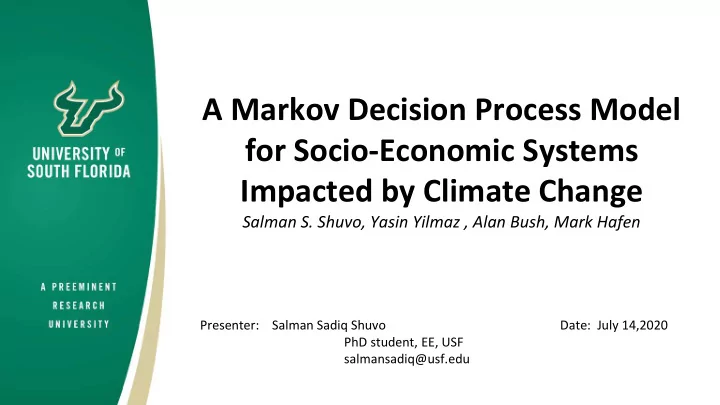

A Markov Decision Process Model for Socio-Economic Systems Impacted by Climate Change Salman S. Shuvo, Yasin Yilmaz , Alan Bush, Mark Hafen Presenter: Salman Sadiq Shuvo Date: July 14,2020 PhD student, EE, USF salmansadiq@usf.edu
Outline ❖ Introduction ❖ MDP Model ❖ Optimal Policy ❖ Simulation Results ❖ Conclusion
Climate Change and Sea Level Rise
Sunny Day Flooding Jul 16, 2019 ❏ In 2018, the number of days with high-tide flooding in the US tied the record set in 2015. In the coming year - from May 2019 through April 2020- experts expect that record to be broken. ❏ ‘Sunny - day flooding’ is projected to put parts of the US underwater for at least 100 days per year by 2050. October 17, 2016 in Brickell, Miami
Sea Level Rise in Tampa Bay ❖ Tampa Bay one of the 10 most at-risk areas on the globe (World Bank study). ❖ $175 billion loss in a storm the size of Hurricane Katrina. ❖ “Flooding in Florida will eventually cost the state regardless of whether a hurricane hits it” (WP, 9/10/17, Report by Risky Business) ❖ In 12 years, the value of property that will be lost to sinking land and rising water will amount to $15 billion. By midcentury, that figure is likely to increase to $23 billion, the report said.
Markov Decision Process(MDP) Model
MDP Model: State Transition
MDP Model: Government ● Government makes a decision about degree of investment in infrastructure improvement against SLR, e.g., storm water drainage system, sea wall, levee, etc. ● Cost function ● denotes residents’ decision to support government’s investment ● denotes cost from nature, e.g., flooding, storm surge, etc. ● discount factor defines the weight of future costs in the agent’s decisions. ● Time unit could be a year, two years, … and Cost unit could be $100 M, $1 B, … ● Three different entities in the cost definition are combined by adjusting the parameters .
MDP Model: Nature •Sea level rise is modeled as • • is set to match the mean SLR to different NOAA projections for St. Pete, FL •Nature’s cost is modeled as
MDP Model: Residents ● Residents’ decision governed by ● denotes residents’ cooperation index ● For high probability of support, recently there must be both government investments and some serious cost from nature ● That is, residents are typically followers; they are serious only when both government and nature are serious!
Optimal Policy • A rational government tries to minimize the expected cost by choosing its actions. • Bellman Equation:
Optimal Policy
Deep Q Learning (DQN) for Optimal Policy
Simulation for Tampa Bay Region
Results: Total cost as a function of cooperation indices for 3 scenaios Intermediate Low Intermediate High
Results: Shortsighted Policy ❖ An reactive/responsive real-world government improves infrastructure after experiencing a significant cost from the nature. ❖ Shortsighted government makes yearly investment whenever cost from nature is higher than a predetermined threshold.
Results: Shortsighted vs. MDP based Policy
Collaboration with policymakers from the Tampa Bay area ❖ Douglas Hutchens, Deputy City Manager, the City of Dunedin. ❖ Melissa Zornitta, Executive Director,Hillsborough County Planning Commission ❖ Mark Hafen, Member,Tampa Bay Climate. Science Advisory Panel. ❖ Vik Bhide, Director, Transportation and Stormwater Services at City of Tampa ❖ Alison Barlow, Executive Director,St. Petersburg Innovation District
Concluding Remarks •MDP model for government’s investment decisions. •Optimal policy is proactive: monitors sea level. • Convergence for RL algorithm that finds optimal policy. •Optimal policy achieves much less cost than shortsighted policy. •Cooperation matters: responsive governments and residents significantly decrease the expected cost.
Thank You
Recommend
More recommend